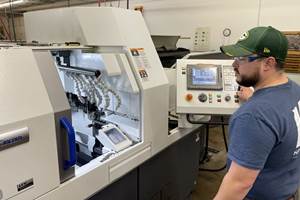Software Leads To Integration In The Job Shop
Jim Andries of Stremel Manufacturing had a vision of his company's software and employees working together. After several years of piecemeal software purchases, Mr. Andries' vision turned into a true need for shop integration.
Share





Jim Andries of Stremel Manufacturing (Minneapolis, Minnesota) had a vision of his company's software and employees working together. After several years of piecemeal software purchases, Mr. Andries' vision turned into a true need for shop integration.
When Stremel required a CAD/CAM program for its fab shop, the company turned to Merry Mechanization (Englewood, Florida). Later, Vantage, a shop control package from DCD (now Epicor of St. Louis Park, Minnesota), was brought in. Then followed a TekSoft (Scottsdale, Arizona) design and manufacturing package, as well as Machine Shop Estimating from Micro Estimating Systems (New Berlin, Wisconsin), SolidWorks from SolidWorks (Concord, Massachusetts), and more recently, CAMWorks, a TekSoft CAM program that operates within SolidWorks.
The addition of Machine Shop Estimating (MSE) brought not only a more accurate method of estimating, but it showed that integration was a realistic goal. MSE was a tool that helped ensure accurate job estimates, but more importantly, a successful, transparent interface existed between Machine Shop Estimating's speeds and feeds libraries and Mr. Andries' two TekSoft programs. Still, the software picture at Stremel as a whole left Mr. Andries seeking more. Now Mr. Andries had more accurate estimates, but he had to find a way to avoid manually reentering them into Vantage.
Help for Mr. Andries to improve his software compatibility came from distributor Kevin Bork of CAM Solutions (Bloomington, Minnesota). Mr. Bork was familiar with each program and recognized that the overlapping capabilities created workload redundancies at Stremel. Understanding the value of the integrated concept proposed, Mr. Bork got on board the integration effort.
Mr. Andries and Mr. Bork began contacting vendors about integration. In addition to working with Stremel, some software developers began working among themselves to improve their information transfer. Mr. Bork developed the crucial link himself, between Vantage and MSE. With those systems linked now, there have been fewer errors and less redundancy.
"Our customers send their native files directly to us over our phone lines. This (SolidWorks) creates a 3D picture, from which CAMWorks will automatically generate a tool path," Mr. Andries says.
Because the two TekSoft CAD/CAM programs in place at Stremel have interfaces to the machine speeds and feeds libraries in Machine Shop Estimating, the tool information used on the shop floor and in the drawings for parts is the same information the estimator uses. This reduces variances. Having fewer libraries also reduces clerical errors and redundant data entry efforts. The libraries are updated and corrected once, throughout the entire system. It also helps ensure that tool default parameters used to generate tool paths from blueprints submitted by customers are set up properly.
The latest phase of the integration plan is a DNC program. It links the shop's machining center programs and setup sheets with Vantage's Document Management capability without the expensive memory upgrades which would otherwise have been required to store the shop's existing part programs. Now the machining centers are linked to a server which downloads data to all the workcenters simultaneously, allowing operators to view part programs and print out setup sheets from any shop computer. The new system provides the shop employees the flexibility and access to information they need, but it also protects the information by restricting Gcode file editing capability via logon names.
"Since we can tie the DNC system with Vantage, operators will gain access to inspection reports, setup sheets, tool lists, diagrams describing setup—even digital photographs of the setup, or a video," Mr. Andries says.
Stremel's commitment to integrated shop technology has not been inexpensive, but Mr. Andries thinks it has given him an advantage over his competitors.
Related Content
6 Machine Shop Essentials to Stay Competitive
If you want to streamline production and be competitive in the industry, you will need far more than a standard three-axis CNC mill or two-axis CNC lathe and a few measuring tools.
Read MoreIncrease Savings and Streamline Purchasing Operations with Amazon Business
Machine shops and small manufacturers are finding cost and time savings using Amazon Business in their shops.
Read MoreERP Provides Smooth Pathway to Data Security
With the CMMC data security standards looming, machine shops serving the defense industry can turn to ERP to keep business moving.
Read MoreMachine Monitoring Integrates With ERP to Reduce Errors
By investing in machine monitoring that links machine data with the shop’s ERP system, this machine shop broke down communication barriers and dramatically reduced errors.
Read MoreRead Next
Machine Shop MBA
Making Chips and 91ÊÓƵÍøÕ¾ÎÛ are teaming up for a new podcast series called Machine Shop MBA—designed to help manufacturers measure their success against the industry’s best. Through the lens of the Top Shops benchmarking program, the series explores the KPIs that set high-performing shops apart, from machine utilization and first-pass yield to employee engagement and revenue per employee.
Read MoreAMRs Are Moving Into Manufacturing: 4 Considerations for Implementation
AMRs can provide a flexible, easy-to-use automation platform so long as manufacturers choose a suitable task and prepare their facilities.
Read More




















